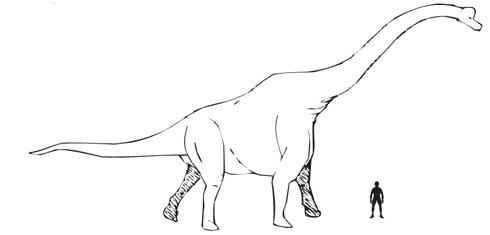African and American Brachiosaurs had a Chinese Cousin
Brachiosaurus had a Chinese Cousin
Brachiosaurus is one of the most popular of all the long-necked sauropods. Most children have at least one “arm lizard” in their dinosaur collection, however, the brachiosaurs and the genus which was named and described formerly over one hundred years ago are still very capable of springing a surprise or two. For example, a type of Brachiosaurus has been discovered in China, the first dinosaur of this type ever to be discovered in that country.
A Chinese Cousin to a Brachiosaur
In a paper published in the scientific journal Proceedings of the Royal Society Biology, the Chinese researchers describe the fossilised remains of a member of the Brachiosauridae family. The fossils were found in the Yujingzi Basin in north-western Gansu Province, in strata dated to the Cretaceous, approximately 100 million years ago. The Chinese team comment on the notion that many palaeontologists believe that the sauropods went into relative decline during the Cretaceous, after their heyday in the Jurassic with the ornithopods becoming more diverse and numerous. However, a number of new sauropod species have been discovered in Cretaceous sediments, so perhaps this particular type of dinosaur was more common in the Cretaceous than previously thought.
The animal has been named Qiaowanlong kangxii (we think the name is pronounced something like chi-oh-wan-long kang-zee), it was relatively small for a brachiosaurid with an estimated length of 12 metres, standing 3 metres tall and weighing perhaps as much as a bull African elephant. The name refers to the Qing Dynasty emperor called Kangxi but also includes the Chinese for “bridge”, “bend in a stream” and “dragon” references to the fossil site and a dream the emperor is supposed to have had.
Qiaowanlong kangxii
The fossils were discovered in 2007 and consist of some articulated cervical vertebrae (neck bones) plus elements of the right pelvic girdle. The fossils have been associated with the late brachiosaurid Sauroposeidon (Sauroposeidon proteles) whose fossils are known from Oklahoma in the USA.
An Illustration of a Typical Brachiosaur

Picture credit: Everything Dinosaur
Two of the main researchers, Hai-Lu You of the Chinese Academy of Geological Sciences in Beijing and Da-Qing Li of Gansu Provincial Bureau of Geo-exploration and Mineral Development have identified the fossil remains as a new genus and species of this group of “arm lizards”.
Everything Dinosaur stocks a wide range of sauropod models including replicas of Chinese sauropods in the: PNSO Age of Dinosaurs model range.
Brachiosaurs
It is hoped that this research along with other dinosaur discoveries will help scientists to piece together the ancient environment of Laurasia during the Cretaceous, when sea levels were rising and the continents were beginning to break up. Clearly however, brachiosaurs, which are believed to have originated in Africa or North America were able to migrate across land bridges into Asia during this time. Similar work is being carried out with scientists working in remote parts of Angola to determine what the fossils found in those deposits can tell us about the opening up of the Atlantic.
To read more about the work in Angola: Angola Starts to Give up Its Dinosaur Secrets.
The Chinese team are confident that more dinosaur specimens will be discovered in the area and that they will help provide data on the geographic distribution of different types of prehistoric animal.

